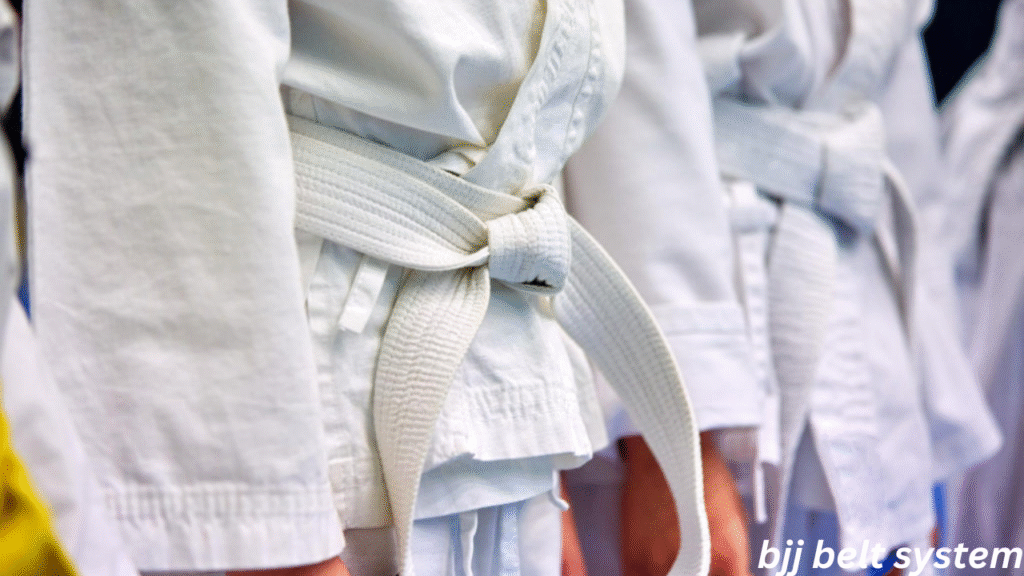Brazilian Jiu-Jitsu (BJJ) is more than just a martial art—it’s a lifelong journey of discipline, learning, and self-discovery. One of the most iconic aspects of BJJ is its belt system, which serves as both a symbol of progress and a roadmap for personal development. Unlike many traditional martial arts, the BJJ belt system is deeply rooted in real-world skill and live application, rather than formalized patterns or katas.
In BJJ, belts are not handed out easily. They are earned through consistent effort, technical growth, and the ability to apply techniques under pressure. This makes the journey through the ranks highly respected and meaningful. Whether you’re a white belt just starting out or a black belt refining your teaching skills, each stage of the BJJ belt system represents a different phase in your evolution as a grappler.
This article offers an in-depth look into the BJJ belt system, explaining what each belt means, how promotions work, and what practitioners can expect at different stages. We’ll also explore the children’s belt system, address common controversies, and answer frequently asked questions to help demystify the path for newcomers and veterans alike.
The Philosophy Behind the BJJ Belt System
History and Origin
The BJJ belt system finds its roots in Judo, the Japanese martial art from which Brazilian Jiu-Jitsu evolved. In the early 20th century, Mitsuyo Maeda, a Judo expert, brought the art to Brazil, where the Gracie family adapted and evolved it into what we now know as BJJ. As the art changed, so did the way belts were awarded. While Judo focused heavily on throws, BJJ emphasized ground fighting, creating a need for a belt system that reflected proficiency in grappling and submission.
Principles of Belt Promotion

Unlike arts with standardized curriculums and timed belt tests, BJJ promotions are often based on a combination of technical knowledge, live sparring ability, and mat experience. Promotions are typically decided by instructors who assess not just a student’s ability to perform techniques, but also their ability to adapt, survive, and apply those techniques in live scenarios. This makes BJJ’s belt progression more organic and performance-based.
Belt Color Meaning and Symbolism
Each BJJ belt color carries its own symbolic meaning. The white belt is the stage of humility and learning. Blue represents survival and foundational growth. Purple marks a transition into deeper strategy and individual expression. Brown symbolizes refinement, and black represents a lifetime of learning, with each degree beyond black signifying continued dedication and contribution to the art.
Adult BJJ Belt Progression
White Belt
The white belt is where every journey begins. It’s a period of information overload, where students are primarily focused on surviving, defending, and absorbing the basic principles of position, leverage, and timing. At this level, progress can feel slow, but every small gain builds the foundation for future belts. Most students spend 1 to 2 years at this level, depending on their training frequency and retention.
Blue Belt
At blue belt, the student begins to transition from defense to offense. They have a working knowledge of fundamental positions like guard, side control, and mount, and begin experimenting with submissions and sweeps. However, this phase also comes with its own challenges—commonly referred to as the “blue belt blues.” Many practitioners lose motivation or become discouraged, as the novelty of learning wears off and the reality of the long journey ahead sets in.
Purple Belt
The purple belt is often seen as the most creative stage in a BJJ practitioner’s journey. By this point, students have developed a solid game and begin refining their style. They start coaching lower belts and may lead warm-ups or teach classes under supervision. Technical depth becomes more important than breadth, and strategy begins to take precedence over brute force.
Brown and Black Belt
The brown belt is a phase of sharpening and leadership. Brown belts polish their strongest positions and prepare to take on more responsibilities within the academy. The transition to black belt represents not just technical mastery, but also a philosophical shift. Black belts are expected to teach, mentor, and contribute to the growth of the sport. Beyond black, degrees are awarded every few years as symbols of time and continued involvement.
Children’s BJJ Belt System
Differences from the Adult System
The kids’ BJJ belt system differs significantly from the adult one. Since children are still growing physically and mentally, their progression system includes more belts to maintain motivation and engagement. Promotions are often faster to reward consistency and effort.
Belt Colors and Progression
Children typically progress through white, gray, yellow, orange, and green belts, with several striped variants in between. These belts act as milestones, encouraging younger students to stay committed and improve steadily. Around the age of 16, students may transition to the adult belt system, usually starting at blue belt based on their skill level.
Promoting Discipline and Development in Kids
Beyond physical skills, the children’s BJJ system places strong emphasis on discipline, respect, and personal growth. Instructors use the belt system to reinforce positive behaviors, setting short-term goals to build long-term character.
Stripes and Promotion Criteria
What Are Stripes?
Stripes are smaller milestones awarded within each belt. Typically, a belt will have up to four stripes before the practitioner is eligible for promotion to the next belt. Stripes serve as a motivational tool and provide tangible progress for students who may not yet be ready for the next color.
Promotion Considerations
Promotion isn’t just about showing up. Instructors evaluate technical knowledge, sparring effectiveness, consistency, and overall attitude. For some academies, competition performance also plays a role, while others focus purely on in-class progress.
Belt Tests vs. Organic Promotion
While some schools use formal belt tests, many BJJ academies opt for organic promotions based on instructor observation. Both methods have their merits, but organic promotion allows for a more personalized, holistic evaluation of the student.
Common Controversies and Misconceptions
Time-Based vs. Merit-Based Promotion
Some practitioners argue that belt promotions should be based strictly on performance, while others believe a minimum time is essential to ensure maturity. This debate often varies by academy, affiliation, and instructor philosophy.
Fast-Tracking and Belt Inflation
“Belt factories” or gyms that promote too quickly have become a concern in the BJJ community. Rapid promotions can dilute the meaning of each belt and harm the reputation of legitimate practitioners who have spent years earning their ranks.
Cross-Training and Belt Recognition
Switching gyms can sometimes lead to friction regarding belt recognition. Not all schools honor ranks earned elsewhere, especially if there’s a significant difference in standards. Communication between instructors can usually resolve such conflicts.
Conclusion
The BJJ belt system is much more than a series of colored belts—it’s a journey that teaches resilience, patience, humility, and continuous learning. Each belt signifies a new phase of growth, not just technically but personally and philosophically. Whether you’re a child learning discipline or an adult striving for mastery, the belt system offers a powerful framework for transformation.
FAQs
How long does it take to get a black belt in BJJ?
A: On average, it takes 8 to 12 years, depending on consistency and skill development.
Can you skip belts in Brazilian Jiu-Jitsu?
A: It’s rare, but some advanced practitioners entering from other grappling backgrounds may start at higher belts.
Do competition wins influence belt promotion?
A: For some schools, yes—competitive success may accelerate promotion, but it’s usually not the sole factor.
What’s the difference between a black belt and a coral belt?
A: A coral belt (red-and-black or red-and-white) is awarded to 6th and 7th-degree black belts, reflecting decades of dedication.
Is it possible to get demoted in BJJ?
A: While extremely rare, demotions can happen due to misconduct or severe skill discrepancies.
You May Also Read: https://duzznews.com/how-much-does-caseoh-weigh/



